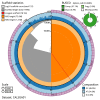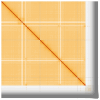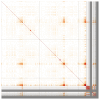A chromosomal reference genome sequence for the malaria mosquito, Anopheles nili, Theobald, 1904
- PMID: 41084634
- PMCID: PMC12515363
- DOI: 10.12688/wellcomeopenres.23198.1
A chromosomal reference genome sequence for the malaria mosquito, Anopheles nili, Theobald, 1904
Abstract
We present a genome assembly from an individual male Anopheles nili (the malaria mosquito; Arthropoda; Insecta; Diptera; Culicidae), from a wild population in Cameroon. The genome sequence is 195 megabases in span. Most of the assembly is scaffolded into three chromosomal pseudomolecules with the X sex chromosome assembled. The complete mitochondrial genome was also assembled and is 15.4 kilobases in length.
Keywords: African malaria mosquito; Anopheles nili; chromosomal; genome sequence.
Copyright: © 2024 Nsango SE et al.
Conflict of interest statement
No competing interests were disclosed.
Figures





References
-
- Gillies MT, Coetzee M: A supplement to the Anophelinae of Africa south of the Sahara (Afrotropical region).The South African Institute for Medical Research,1987. Reference Source
LinkOut - more resources
Full Text Sources

